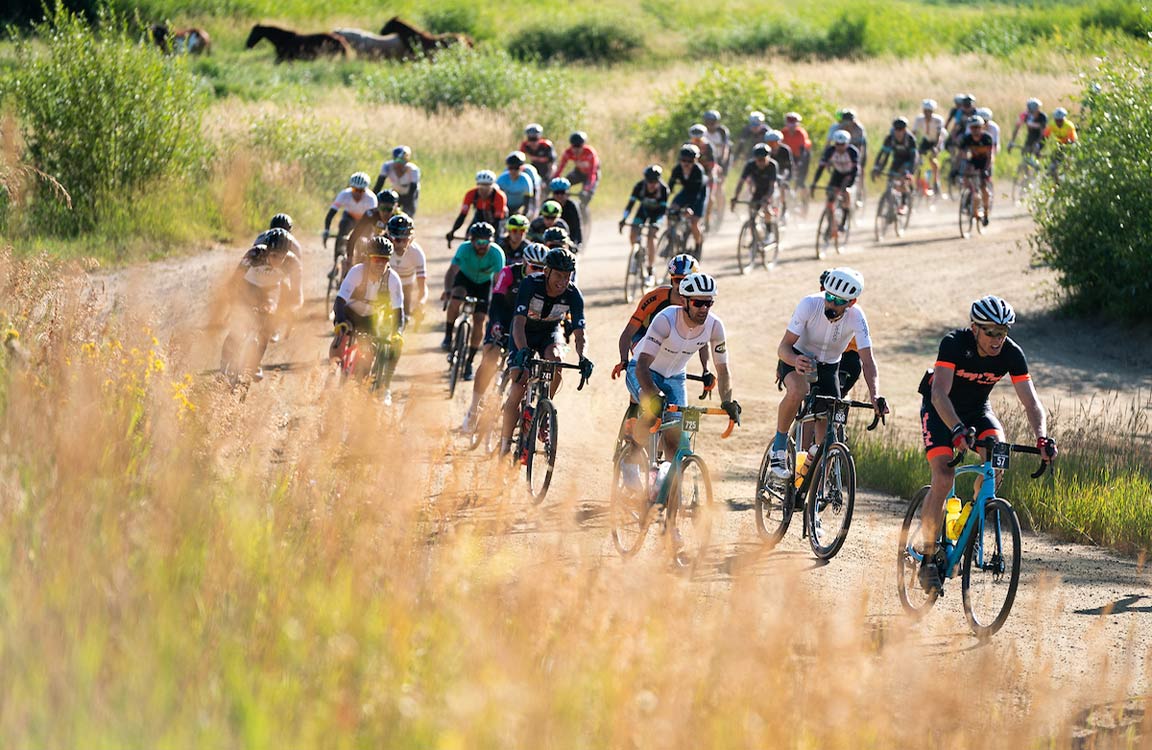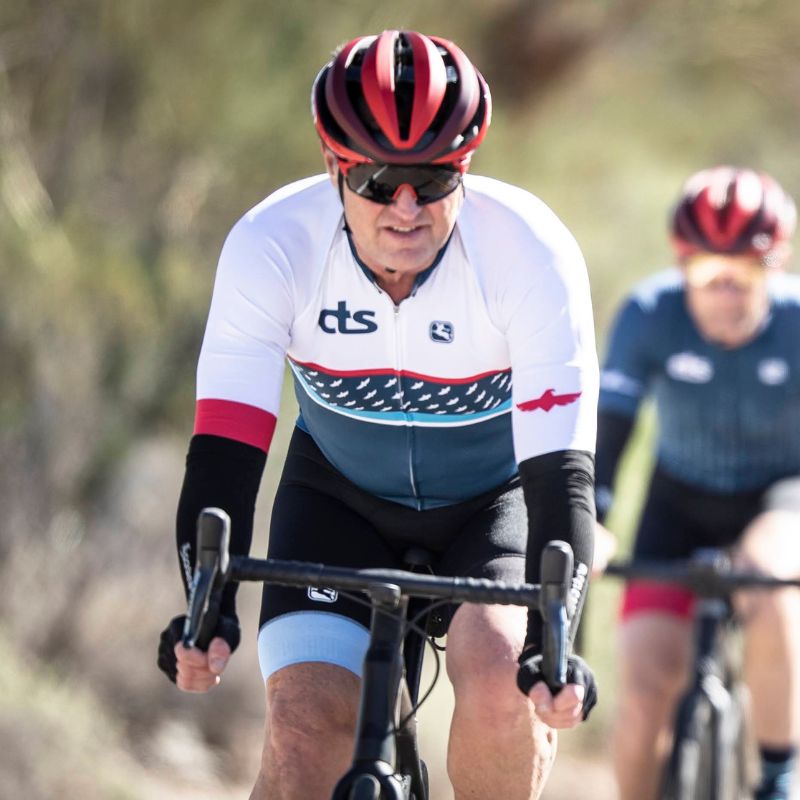
7 Performance Tips for Gravel Racing
By Chris Carmichael,
CTS Founder and Chief Endurance Officer
Whether you are planning on racing SBT GRVL or preparing for another gravel event, here are some tips from my gravel racing experiences at SBT, Unbound Gravel, and others:
Eat your breakfast
Take the time to figure out what kind of pre-race breakfast works for you. There’s no perfect formula, but I think one of the keys is to avoid overeating. Even though the day is going to be long and you’ll burn a ton of calories, stuffing yourself with a huge breakfast isn’t going to give you the energy to make it through the day. That comes from the glycogen in your muscles, the fat you’re carrying around, and the food you eat during the race.
Keep breakfast to a moderate size. Personally, rice and eggs works well for me, with some toast and coffee. I prefer to start events on the borderline of feeling hungry. That way I can start eating right away on the bike without overloading my system. If you have food in your pockets and feed stations, you can easily consume more calories if you underestimate your needs. But if you overestimate and end up bouncing down the road with a full stomach, there’s not much you can do but feel nauseated and wait until it digests.
Start hard…
It’s tempting to roll slowly off the start line of a long gravel event that’s going to take 8+ hours, but it pays to go out hard – at least for a little while. With the pros leading the way, gravel race starts are fast. You want to use the speed of those groups to put some good miles behind you and stay with people you can work with later. If you start too conservatively, you’re likely to be the strongest rider in the groups you’re with, meaning the other riders aren’t much help.
Feel Stronger in 6 Weeks — No Matter Your Age
Climbs feel steeper? Recovery slower?
You’re not done getting faster — you just need a smarter plan.
The 6-Week Masters Power Build Coaching Program is designed for cyclists 50+ who want to boost power, recover faster, and ride stronger — all with expert 1:1 coaching.
- Personalized 6-Week Training Plan
- 1:1 Coaching + TrainingPeaks Premium
- Mobility & Strength Bonus Guides
💪 Guarantee: Stronger or free.
Start your 6-week journey for $149… But keep your ego in check
As the front groups start to split up, it’s important to avoid burning too many matches trying to ride above your level. It’s going to be a long day, and digging too deep too early will come back to haunt you several hours later. As an old bike racer, my instinct is still to do whatever is necessary to stay on the wheel, but a number of times during gravel races I’ve had to consciously decide to let the wheel go. It’s a balancing act; going out hard enough to get into good groups, but then knowing when to back off to conserve strength for later.
Top up at feed stations
If your finishing time is important to you, don’t spend a lot of time in feed stations, because you’re just giving back time you earned on the way there. To keep my stops short, I fill and drink a bottle of plain water, and then fill one bottle with sports drink and one with water, grab food like gels and ProBar Bolts, and leave. I eat on the bike while rolling rather than standing around eating at the feed station, but I drink a full bottle because it’s kind of a way to leave the feed station with three bottles (one in my gut and two on the bike).
Separate hydration from energy
The speeds in gravel racing are sometimes relatively slow because of the loose surface. The climbs can get very hot. By separating hydration (water and electrolyte drinks) from energy (gels, chews, other foods) you can adjust your fluid intake based on intensity and temperature without overloading your gut with calories. This dramatically reduces the chances for gastric distress during long endurance races.
Get loose
The variable road surface in gravel racing demands your constant attention, and there will be some sliding and drifting going on. The more tense you are, the more the gravel will beat you up, and the more likely you are to overcorrect for a slight drift or bobble and make it worse. Let the bike find the line, stay nimble in the saddle, and keep your upper body loose and relaxed.
► Free Cycling Training Assessment Quiz
Take our free 2-minute quiz to discover how effective your training is and get recommendations for how you can improve.
The handling skills for gravel take practice, even if you’ve been riding the road or mountain bike for decades. The more experienced you are on road or trail, the faster you’ll pick up the skills for gravel, but you still need practice. This is particularly true for SBT GRVL, because of the longer descents. You pick up more speed than you do in the shorter, rolling hills of Kansas or other gravel events.
Do your homework
Long gravel races are not something you want to just sign up and show up for. Each race has different logistics to consider, and there’s less standardization in the gravel racing community compared to road, track, and cross-country mountain bike racing. Races have slightly different rules, different philosophies on feed stations and mechanical assistance, and of course, different terrain.
For SBT Gravel, CTS organizes a recon camp in Steamboat the week of the event. We ride parts of the courses, learn as much as we can about the race, practice skills on the terrain we are going to race on, and talk strategy. These camps include an entry to the race, too. Although the 2023 camp is sold out, here’s information on the 2023 SBT GRVL camp so you can plan ahead for 2024.
► FREE Mini-Course: Learn How to Maximize Your Limited Training Time
Learn step-by-step how to overcome limited training time and get faster. Walk away with a personalized plan to increase your performance.
"*" indicates required fields


Comments 11
Chris, Good tips on racing/riding in mass start gravel events! After doing Unbound 200 in ’21 I adjusted my strategy for ’22;
– Go harder at the start to stay in the draft of fast and strong riders. I knew from last years’ experience that my pace was going to slow in the last 1/3rd of the race regardless of how fast or slow I started. By staying with the faster start of the race, as my pace slowed towards the end of the race, I could still find racers to work with and share the load/motivation.
– Keep moving at the aid stations. I got what I needed from my drop bags/feed station and got out. I let the support crew do the work filling bottles/hydration pack and I concentrated on making sure I grabbed fuel to get me through to the next aid station/finish line.
– At the start of the race and at aid stations I packed water and food for a reason, to drink and eat on the bike. In ’22 my motto was, “Drink and eat all you’re packing before the next aid station”.
I finished 13% faster in ’22 vs ’21.
– A strategy I haven’t changed is keeping my ass off the saddle in the technical sections. I hope that my streak of no flats in gravel racing continues!
Pingback: Trainright Guide to Gravel Racing and Training - CTS
Pingback: Chris Carmichael’s List of the “Best of 2019” - CTS
Pingback: episode 101: anatomy of an effective, consumer-focused event, with mark satkiewicz of SBT GRVL - Channel Mastery
“With the pros leading the way, the start at SBT was fast, and I worked to stay in the front groups through the first feed station. ”
Stunning. According to Athlinks, you finished 177th. If this is even close to accurate, it had to be a hellish day for you. Why would you recommend such an approach to amatueurs? For people with less courage and experience than you, it would almost certainly lead to a DNF.
I think you may be reading into the advice. They’re not suggesting you try to stay up with the pros (that is, unless you think you’ve got the chutzpah). What they’re saying is ride the (energy) wave of the race start for a bit (push yourself some) and then settle into a manageable pace. I’m an experienced amateur gravel racer and I totally concur with this. Going slow out of the gate just means a really long day and you might not make time cutoffs, if applicable. The longer you’re on gravel, the more fatigued your body will get.
Solid advice all the way around!
Crazy timing! Just picked up my new bike Thursday, and christened it today on a two hour gravel shop ride in upstate NY. This is the first “gravel specific” bike for me. Previously I always rode cx bikes with cantilever brakes and mechanical groupsets. I had a blast!! Just about everything you mentioned came into play for me this morning, even though I was only riding for two hours. I’m looking forward to doing a lot more gravel riding. Among other things it’s a safer place to be on a bike than the roads I’m on with my road bike and if I train alone outside I do worry.
SBT is on my bucket list – will have to do some research to see how the black course compares to Unbound before I throw my hat in the ring for it though. The camp before the race sounds great, not sure how it will fit into a taper for the event though.
Steve:
oh don’t worry we won’t “overcook you” before the race. Here is what a draft of the camp schedule:
camp check in Tuesday afternoon
Wednesday 3hrs recon ride on the most challenge gravel sections
Thursday 2hrs recon on the last few climbs on the course
Friday 1.5hrs easy spin on hard packed gravel (the first 15miles or of the race)
Saturday 1-1.5hrs on the final run in (last 10miles or so ) of the race
Sunday race
Included coaching, training lectures, meals, nutritional products, mechanical support, massage
I hope you can join us….so much fun
Chris
Thanks Chris, Sounds like a blast! Hopefully I can make it.
Great recap Chris and some very useful tips! I especially like the go out hard comment. I tend to try to conserve energy early and pace myself but that can often lead to spending a lot of miles by myself. If I think of some of my most successful races, I always went out “too hard”, but ended up finding a group and hanging on. This ended up making me push myself to do more than I thought I could and finishing stronger than I would have on my own. Great week in Steamboat and hope to see you there next year!